 W
WThe British Rail Class 185 Desiro is a class of diesel multiple-unit (DMU) passenger trains built by Siemens Transportation Systems in Germany for the train operating company First TransPennine Express. They are currently operated by TransPennine Express.
 W
WThe British Rail Class 350 Desiro is a class of electric multiple-unit passenger train in use by West Midlands Trains under its London North Western Railway sub-brand. 87 four-car units were built by Siemens Mobility between 2004 and 2014 across four sub-classes.
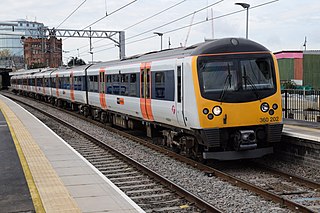 W
WThe British Rail Class 360 Desiro is an electric multiple-unit class that was built by Siemens Transportation Systems between 2002 and 2005. The Class 360 is currently operated by East Midlands Railway and Rail Operations Group.
 W
WThe British Rail Class 374, also referred to as the Eurostar e320, is a type of electric multiple unit passenger train used on Eurostar services through the Channel Tunnel to serve destinations beyond the core routes to Paris and Brussels. They began to run passenger services in November 2015. The trains, owned by Eurostar International Limited, are sixteen-coach versions of the Siemens Velaro. Each train is 390.2 m (1,280 ft) long. The trains are designed to be compliant with the Technical Specifications for Interoperability (TSI).
 W
WThe British Rail Class 380 Desiro is a type of electric multiple-unit train that operates on the National Rail network in Scotland, for Abellio ScotRail.
 W
WThe British Rail Class 444 Desiro is an electric multiple-unit passenger train built by Siemens Transportation Systems in Austria between 2002 and 2004. The Class 444 currently operate on express passenger services for South Western Railway.
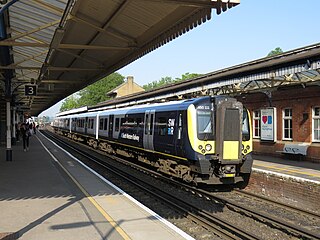 W
WThe British Rail Class 450 Desiro are third-rail DC electric multiple-unit (EMU) passenger trains that began service during 2003. The class 450 is used for outer-suburban services, the Class 450s were built with standard and first-class accommodation. The trains have a maximum speed of 100 mph (161 km/h).
 W
WThe British Rail Class 700 Desiro City is an electric multiple-unit passenger train, built between 2014 and 2018, for use on the Thameslink network, as part of the Thameslink Programme in the United Kingdom. As of 2021, they are operated by Govia Thameslink Railway.
 W
WThe British Rail Class 707 Desiro City is an electric multiple unit. Siemens Mobility built 30 five-carriage sets for South West Trains. Currently in use by South Western Railway, they will be transferred to Southeastern in 2021.
 W
WThe British Rail Class 717 Desiro City is an electric multiple unit passenger train built by Siemens Mobility, currently operated by Govia Thameslink Railway on its Great Northern Hertford Loop and Welwyn stopping routes. Built to replace Class 313 trains on services into Moorgate, a total of 25 six-car units began entering regular service from March 2019.
 W
WCivia is the name for a class of electric multiple unit trains built by CAF and Siemens for the RENFE Cercanías commuter railway networks in Spain. The first units entered service in 2003.
 W
WThe Siemens Desiro is a family of diesel or electric multiple unit passenger trains developed by Siemens Mobility, a division of the German Siemens AG conglomerate. The main variants are the Desiro Classic, Desiro ML, Desiro UK and the later Desiro City, Desiro HC and Desiro RUS. The trains are mostly used for commuter and regional services, and their rapid acceleration makes them suitable for services with short distances between stations. The design is flexible, and has become common in many European countries.
 W
WThe Siemens Desiro is a family of diesel or electric multiple unit passenger trains developed by Siemens Mobility, a division of the German Siemens AG conglomerate. The main variants are the Desiro Classic, Desiro ML, Desiro UK and the later Desiro City, Desiro HC and Desiro RUS. The trains are mostly used for commuter and regional services, and their rapid acceleration makes them suitable for services with short distances between stations. The design is flexible, and has become common in many European countries.
 W
WDBAG Class 411 and Class 415 are German tilting electric multiple-unit high-speed trains in service with DB Fernverkehr, commonly known as ICE T.
 W
WThe DBAG Class 605, commonly known as the ICE TD is a high-speed diesel multiple unit (DMU) train, formerly in service with Deutsche Bahn and DSB.
 W
WThe Intercity Express is a system of high-speed trains predominantly running in Germany. It also serves some destinations in Austria, Denmark, France, Belgium, Switzerland and the Netherlands mostly as part of cross border services. It is the highest service category of rail and the flagship train of the German state railway, Deutsche Bahn. There are currently 259 trainsets in use. ICE trains are the highest category trains in the fare system of the Deutsche Bahn. Their fares are not calculated on a fixed per-kilometre table as with other trains, but instead have fixed prices for station-to-station connections, levied on the grounds that the ICE trains have a higher level of comfort. Travelling at speeds up to 320 km/h (200 mph), they are tailored for business travellers or long-distance commuters and are marketed by Deutsche Bahn as an alternative to flights.
 W
WThe Kaohsiung MRT has operated Siemens Modular Metro (Mo.Mo) electric multiple unit (EMU) trains on the heavy-rail Red and Orange Lines since its opening in 2008.
 W
WThe Lastochka is a German/Russian train. It is a commuter intercity electric multiple unit train used across multiple Russian cities, based on the Siemens Desiro design and manufactured by Siemens and Ural Locomotives.
 W
WÖBB Class 4011 are Austrian tilting high-speed electric multiple-unit trains, in service with Austrian Federal Railway (ÖBB). They were introduced in 2006, when ÖBB purchased three German DBAG Class 411 units, commonly known as ICE T, from the first batch of 32 originally ordered by Deutsche Bahn (DB). These units were renumbered as class 4011 in ÖBB's numbering scheme. Together with 12 DB Class 411, they form a pool for joint operation services between Germany and Austria.
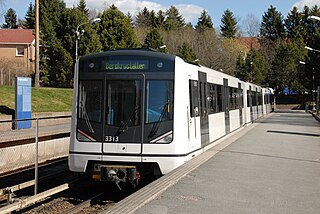 W
WMX3000 is an electric train used on Oslo Metro in Oslo, Norway. The multiple units are produced by Siemens, who started serial delivery in 2007. Seventy-eight three-car units were ordered by Sporveien, and five by Akershus County Municipality. They replaced the older T1000 and T1300 stock that was used on the Oslo Metro since 1966. By 2010, the last T1000 and T1300 trains had been retired and replaced by 83 three-car units. 32 additional sets were ordered, and the final train set was delivered in 2014, increasing the fleet to 115 units.
 W
WThe RENFE Class 447 is a class of electric multiple unit trains built by CAF, Alstom, Siemens, ABB, and Adtranz for RENFE Cercanías, Spain's commuter railway networks. The first units entered service in 1993.
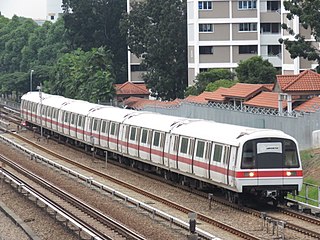 W
WThe trains manufactured by Siemens (SIE) under Contract 651 (C651), sometimes abbreviated to SIE C651 are the second generation electric multiple unit rolling stock in operation on the North South and East West Lines of Singapore's Mass Rapid Transit (MRT) system. A total of 114 cars consisting of 19 train-sets were purchased in 1992 and introduced into service from 1995 onwards. These trains were built by Siemens in Austria.
 W
WThe Siemens Desiro is a family of diesel or electric multiple unit passenger trains developed by Siemens Mobility, a division of the German Siemens AG conglomerate. The main variants are the Desiro Classic, Desiro ML, Desiro UK and the later Desiro City, Desiro HC and Desiro RUS. The trains are mostly used for commuter and regional services, and their rapid acceleration makes them suitable for services with short distances between stations. The design is flexible, and has become common in many European countries.
 W
WThe Siemens Inspiro is an electric multiple unit designed and manufactured by Siemens since 2012 for metro systems. The product was launched on 19 September 2012 at the InnoTrans in Berlin. The first Inspiro entered service with Warsaw Metro on 6 October 2013.
 W
WThe Siemens Mireo is a family of electric multiple units (EMU) designed by Siemens Mobility. It is designed to be a successor to the "Mainline" variant of the company's Desiro EMUs.
 W
WThe Siemens Modular Metro is a family of electric multiple unit trains for rapid transit systems produced by Siemens Transportation Systems and used by rail operators around the world. The vehicle concept was launched in Vienna in 2000 and is a modular concept allowing many variants of metro vehicles. Previously known as Modular Mobility, Siemens, whose rail equipment division has been renamed Siemens Mobility, still uses the abbreviation Mo.Mo; however, these trains are no longer being made, having been replaced by Siemens's new Inspiro family of metro trainsets.
 W
WThe Siemens Nexas is a class of electric multiple units manufactured by Siemens Transportation Systems for the suburban railway network of Melbourne, Australia between 2002 and 2005. The design of the trains was based on the Siemens Modular Metro.
 W
WThe Siemens-Schuckert Orenstein & Koppel is an underground car formerly used on the Buenos Aires Underground first built by Siemens-Schuckert and Orenstein & Koppel in 1934, 1937 and 1944 with a smaller number of cars built in Argentina during the 1950s. The Siemens O&K rolling stock made up the entirety of the trains used on the three lines built by the Hispanic-Argentine Company for Public Works and Finances (CHADOPyF) and has since served on every line of the Underground from 1934 to 2016, with cars refurbished by the Emepa Group and Alstom continued to function on the network till 2017.
 W
WThe Taipei Metro C321 is the second generation of heavy-capacity rolling stock used on the Taipei Metro in Taipei, Taiwan. Built by Siemens and it was introduced in 1999, and it currently serves the Bannan line.
 W
WThe Taipei Metro C341 is the third generation of electric multiple units on the Taipei Metro in Taipei, Taiwan. Built by Siemens Mobility and SGP Verkehrstechnik in Austria, and it was introduced in 2003, and it currently serves the Bannan line.
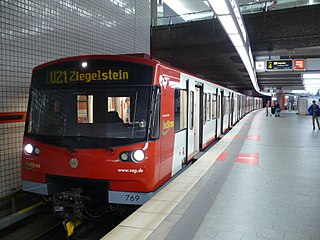 W
WThe VAG Class DT3 is an electric multiple unit (EMU) train type operated by the Verkehrs-Aktiengesellschaft Nürnberg on the Nuremberg U-Bahn system. It is the first type of rolling stock on the Nuremberg U-Bahn that has gangways between the individual cars.
 W
WThe VAL 208 is one of the VAL series, an automated guideway transit system developed by Matra and Siemens. The vehicles are manufactured at Siemens SGP (Simmering-Graz-Pauker) in Vienna, Austria.